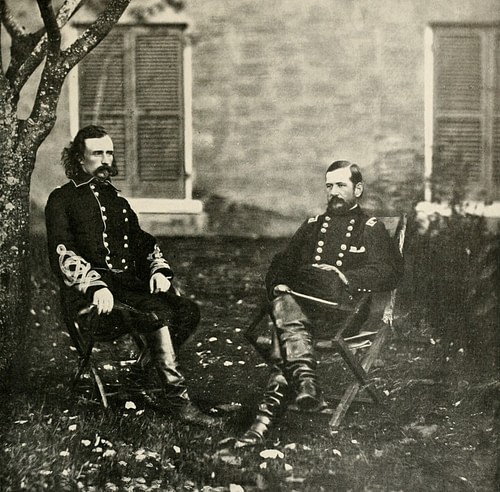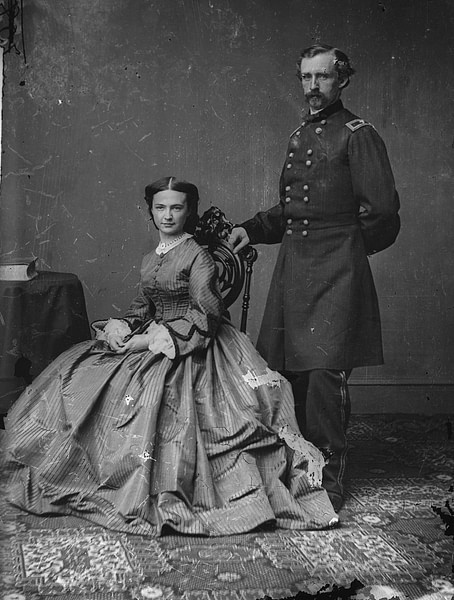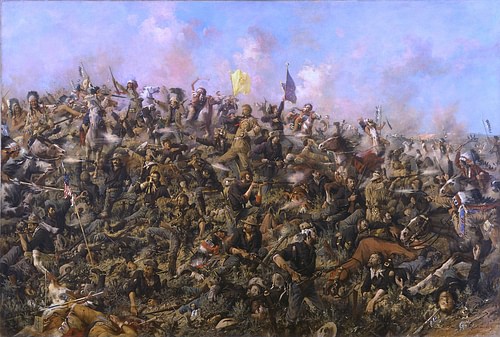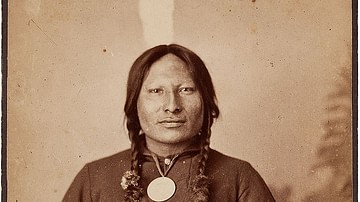
George Armstrong Custer (l. 1839-1876) was an officer in the US Army, serving in the cavalry from 1861 to 1865 during the American Civil War and the wars against the Plains Indians 1866-1876. Although he became a widely recognized hero during the Civil War, he is best remembered for his death at the Battle of the Little Bighorn.
Custer established a reputation for recklessness, courage, and self-promotion early in the Civil War and, by 1863, after the Battle of Gettysburg, was a national hero. He blocked the retreat of General Robert E. Lee (l. 1807-1870) in April 1865 and was present at Appomattox Court House when Lee surrendered to General Ulysses S. Grant (l. 1822-1885). After the war, he oversaw Reconstruction in Texas before taking command of the newly formed 7th Cavalry in campaigns against the Native Americans of the West.
He led his troops against the Cheyenne people at the Washita Massacre/Battle of the Washita River in November 1868 and, ignoring the terms of the Treaty of Fort Laramie of 1868, marched his troops into the Black Hills in 1874 where he discovered gold. News of this discovery soon brought more settlers and miners into Sioux and Cheyenne territory, igniting the Great Sioux War of 1876-1877. At the Battle of the Little Bighorn (25-26 June 1876) Custer and his men were slaughtered by Arapaho, Cheyenne, and Sioux warriors under chief Sitting Bull (l. c. 1837-1890). Afterwards, thanks in large part to the efforts of his wife, Elizabeth Bacon "Libbie" Custer (l. 1842-1933), George Armstrong Custer came to be regarded as a great American hero.
His legacy and reputation held until shortly before the Second World War (1939-45) when scholars began challenging the traditional narrative. Today, Custer is a controversial figure, often condemned for his brutality and ruthlessness. Although Custer should certainly be held accountable for his actions, it must also be recognized that he was primarily advancing the genocidal policies of his government which saw the American Indian as an obstacle to progress, civilization, and Manifest Destiny.
Early Years & West Point
George Armstrong Custer was born on 5 December 1839 in New Rumley, Ohio, to Emanuel Henry Custer, a blacksmith, and his second wife, Marie Ward Kirkpatrick. He was named after a minister as his mother hoped this would encourage him to follow that path. He had three older half-siblings from his mother's first marriage and four full siblings, including Thomas and Boston, who would also join the military and die with him in battle.
He was sent to live with his older half-sister and her family in Monroe, Michigan, to attend school and met the girl who would one day become his wife, Elizabeth Clift Bacon. After graduating, he moved to Hopedale, Ohio, and enrolled at the Hopedale Normal College, pursuing a teaching degree. He began his teaching career in Cadiz, Ohio, in 1856 and boarded at the home of the Holland family, where he fell in love with the daughter, Mary Jane Holland. He hoped to marry her but found little opportunity for advancement in Ohio, so he decided to change careers and apply to West Point Military Academy. Scholar Nathaniel Philbrick comments:
He'd been a seventeen-year-old schoolteacher back in Ohio when he applied to his local congressman for an appointment to West Point. Since Custer was a Democrat and the congressman was a Republican, his chances seemed slim at best. However, Custer had fallen in love with a local girl, whose father, hoping to get Custer as far away from his daughter as possible, appears to have done everything he could to persuade the congressman to send the schoolteacher with a roving eye to West Point.
(47)
Custer entered West Point in July 1857 and, before the end of his first session, had earned 27 demerits. By graduation, he had been given more demerits than any of the other cadets in his class. After graduation in June 1861, he faced court martial for failing to break up a fight between cadets but was only reprimanded as the American Civil War was already underway. Many of Custer's classmates had left to fight for the Confederacy and the Union forces were in dire need of trained officers. Custer was commissioned a second lieutenant and sent to drill volunteers in Washington, D.C.
Civil War Service
Custer was assigned to the 2nd US Cavalry Regiment and fought at the First Battle of Bull Run (First Manassas) on 21 July 1861, distinguishing himself, and helped organize the defense of Washington, D.C., through October of that year when he fell ill and was on sick leave until February 1862. Transferred to the 5th Cavalry Regiment, he fought at the Siege of Yorktown in April-May 1862, serving as an aide to Major General George B. McClellan (l. 1826-1885), who was impressed by the young officer's courage and ambition. During the Peninsula Campaign (March-July 1862), McClellan gave him command of four companies of the 4th Michigan Cavalry. Custer led them in a charge across the Chickahominy River, capturing the enemy and taking the first battle flag of the war.
While on leave in Monroe, Michigan in November 1862, he again met Elizabeth Bacon and later said he fell in love with her at first sight. Custer asked if he could court her, but she was not interested and, further, her father, Daniel Bacon, a judge, rejected Custer as a suitor because he came from a lower-class background and was only a captain in the army.
By June 1863, he was aide to Brevet Lieutenant Colonel Alfred Pleasanton (l. 1824-1897), who was so taken with Custer that he promoted him to the rank of brigadier general of volunteers, making him one of the youngest generals in the army at only 23 years old. After his promotion, and having won over Elizabeth, Judge Bacon gave them his blessing and they were engaged.
Custer distinguished himself at the Battle of Gettysburg on 3 July 1863 several times but, most notably, when he broke the charge of General J. E. B. Stuart (l. 1833-1864). Stuart had been tasked by General Lee with leading a flanking maneuver that would break the Union line at Culp's Hill. Stuart led 6,000 Cavalry while Custer had only 400 left under his command after a day of combat, but he called for battle formation. After his promotion, he designed his own uniform with gold braid and epaulets and wore a red scarf so that his men would know it was him leading from the front. At Gettysburg, he was wearing this uniform when he called on his men to charge and they followed him, crashing into Stuart's column, and scattering it. Custer was then reinforced and, after a brief battle, Stuart retreated. Gettysburg became a stunning Union victory. Custer – already loved by the media who called him "the boy general" – became a war hero overnight.
He married Elizabeth Bacon on 9 February 1864, and she accompanied him on military campaigns throughout the rest of the year. In April 1865, Custer blocked Lee's retreat at Appomattox Court House and was later present when Lee surrendered to Grant. General Philip Sheridan (l. 1831-1888) had the table on which the terms of surrender were signed sent to Libbie Custer, along with a note praising Custer.
Indian Wars
Custer was promoted to Major General and took command of the forces that occupied Texas beginning in June 1865. He mustered out of the service in February 1866 and seemed somewhat lost after four years of war. He loved the army, and civilian life did not agree with him.
He and Libbie returned to Monroe, Michigan, where he considered running for congress but instead accepted an appointment as Lt. Colonel of the 7th Cavalry Regiment and was deployed to Fort Riley, Kansas, in 1866. He commanded troops on scouting missions to locate and destroy those Native American communities that had been designated 'hostile'. Tensions had been rising in the West for decades as treaties were signed and then ignored by US settlers and officials. The Colorado War (1864-1865) and Red Cloud's War (1866-1868) were responses to the US government ignoring the terms of treaties and doing nothing to stop US citizens from encroaching on Native American lands.
Cheyenne attacks on settlements, wagon trains, and travelers, led by warriors including Chief Tall Bull and Roman Nose (Cheyenne Warrior), intensified after the Sand Creek Massacre of Arapaho and Cheyenne in 1864 at the same time as 'peace chiefs' like Black Kettle (l. c. 1803-1868) tried to come to some sort of settlement with the Euro-American invaders. The US government responded to the Cheyenne attacks by sending Major General Winfield Scott Hancock (l. 1824-1886) whose campaign came to be known as Hancock's War. Custer was with Hancock when they attacked the Cheyenne village at Pawnee Fork on 19 April 1867. All the people's homes, food supplies, and personal possessions were burned but the Cheyenne themselves escaped without losses, even though Hancock had ordered the village surrounded.
Black Kettle and the other peace chiefs, in spite of the Sand Creek Massacre and Hancock's War, still tried to find some way to live peacefully with the new arrivals in their lands. The Medicine Lodge Treaty of 1867 was supposed to address their concerns but, like every other treaty, was never honored by the US government. Sheridan sent word to Custer that he had total freedom in dealing with the hostile Plains Indians as he saw fit. Sheridan and Custer agreed on a plan of tracking Native parties to their winter camps, killing the warriors, and holding the women and children for ransom for any White captives the Natives were holding or to force other bands into submission.
On 26 November 1868, Custer came upon a trail that was interpreted by his Osage scouts as left by a war party. Custer followed this to the camp of Black Kettle on the Washita River. The next morning, remembering the lesson of Hancock's attack on Pawnee Fork, Custer ordered his troops to surround the village and watch for any attempt at escape. Black Kettle, meanwhile, had again been promised safety and protection on the Washita and was flying both the American flag and the white flag of truce (or, according to other reports, only the American flag, as it was early morning, and no one had time to raise the white flag before the attack came). There were few warriors in the camp and no 'hostiles' as Black Kettle was an advocate for peace. Custer's troops wound up massacring mostly unarmed women, children, the elderly, and the sick or injured. Cheyenne casualties were given at between 60 and 150, and the 'battle' was hailed by the press as a great victory. Scholar Joseph M. Marshall III comments:
General Philip Sheridan once described Custer…as a "man who wept with his wife at sentimental drama but [who] could ride whooping with his troops over an Indian village full of women and children."
(91)
So it was at the Washita where Black Kettle, his wife Medicine Woman, and other peace chiefs, were killed. The women who were not killed were taken prisoner, and, as Ben Clark, chief of Custer's scouts, later reported, "many of the squaws captured at the Washita were used by the officers" (Philbrick, 138). Monahsetah (l. c. 1850-1922), daughter of the peace chief Little Rock (killed in the massacre), was taken by Custer as his mistress.

According to some accounts, Custer fathered a child with Monahsetah, but it seems he became sterile after a bout of gonorrhea, picked up in New York City when he was a cadet at West Point. He and Libbie never had children, although, according to her, they wanted to, and so it is thought that the father of Monahsetah's light-haired child, born in 1869, was Thomas Custer. It is unclear, owing to conflicting accounts, whether Libbie accepted Monahsetah or forced Custer to send her away, but letters between them suggest "some sort of crisis" in their marriage in the fall of 1870 (Philbrick, 21). Whether this was caused by his affair with Monahsetah, one of the many other women he slept with, or something else, is unknown. Monahsetah was sent back to her people, however, at some point in 1869 or 1870.
Gold, Grant & The Great Sioux War
In 1874, in complete disregard of the recent Fort Laramie Treaty of 1868, Custer led his men into the Black Hills – a site sacred to the Lakota Sioux and promised to them in perpetuity – and discovered gold deposits, which would spark the Black Hills Gold Rush of 1876 and the Great Sioux War.
President Ulysses S. Grant (1869-1877), hearing of Custer's discovery, offered to buy the Black Hills from the Sioux, but they would not sell. Custer, along with other officers, was ordered to force compliance with Grant's ultimatum that the Sioux should move onto reservations by 31 January 1876 or be designated 'hostiles'. Custer was preparing to launch his expedition in March when he was called to Washington, D.C., to testify before Congress regarding allegations that Secretary of War William W. Belknap and Grant's brother Orville had been illegally forming monopolies at the trading posts, charging soldiers exorbitant prices for necessities.
Custer's testimony resulted in Belknap's impeachment and Orville's public humiliation, and he then expected to be allowed to return to his troops. President Grant intervened, however, removing Custer from command. When Custer tried to return to his men, Grant ordered his arrest, which was widely covered by the press, and Grant had no choice but to release the war hero. He insisted, however, that Brigadier General Alfred Terry (l. 1827-1890) lead the campaign against the Sioux, not Custer.
Even so, Custer had been given a free hand in military engagements by Sheridan, and so, when he located Sitting Bull's village in June 1876, he ignored Grant's wishes and prepared to attack. He sent Captain Frederick Benteen (l. 1834-1898) to scout and Major Marcus Reno (l. 1834-1889) to the far side of the village. He planned the operation as he had the Washita Massacre: surround the village and close in with a pincer movement, capturing the women and children and holding them as hostages to force a Sioux surrender.
The Battle of the Little Bighorn (25-26 June 1876), which Custer had hoped would be his great victory, and possibly propel him to the White House in the next election, was instead the most spectacular win for the Sioux, Cheyenne, and Arapaho of the Great Sioux War. No one in Custer's command knew how many warriors Sitting Bull had gathered at his camp nor their resolve in defending their land. When Reno attacked from the far side, instead of meeting a few warriors, women, and children, he faced a full-scale counterattack led by Sioux war chief Gall (l. c. 1840-1894). Reno's charge was routed while Crazy Horse (l. c. 1840-1877) led his warriors against Custer. Benteen tried to support Reno, who was in retreat, but he was forced to join him in fleeing across the river.
Custer and his entire command were killed in what has become known as "Custer's Last Stand." According to Cheyenne history, he was knocked from his horse by the Cheyenne warrior Buffalo Calf Road Woman, while others claim he was killed by the Sioux warrior Rain-in-the-Face (l. c. 1835-1905). Every first-hand account of the battle is consistent in relating the chaos of the day and how no one could see what was happening because of the dust thrown up by the horses, and so it is unclear who killed Custer or how. Many Native veterans of the battle later reported they had no idea they were fighting Custer that day at all.
Conclusion
After his death, despite criticism by Grant and others of his decision to attack before Terry's arrival, Custer became the most famous hero in the United States, depicted as a defender of civilization against the forces of savagery. Newspapers across the country carried the news of the "massacre of our troops" and the death of the gallant Lt. Colonel Custer. His primary defender against criticism and most ardent advocate for his heroic status was Libbie, who wrote letters, embarked on speaking tours, and wrote three books, between 1885 and c1890, establishing Custer's reputation as an American hero who had died defending his country.
This was how Custer was understood, generally speaking, until the middle of the 20th century when modern scholarship began re-evaluating his legacy and Native American history and first-hand accounts were taken more seriously. Contrary to his popular image, Custer – following the orders of his government – was not defending American freedom, but, instead, was advancing the US government's vision of Manifest Destiny at the expense of the people who had lived in Western North America for thousands of years. From the Washita Massacre to the Battle of the Little Bighorn, every one of Custer's engagements with Native Americans was a breach of the Fort Laramie Treaty of 1868, which made clear the United States had no claim to any of those lands.
Custer remains a controversial figure in American history as the value of his legacy continues to be debated. His service during the American Civil War would guarantee him a place in history and, had he gone in a different direction in 1865, he would be remembered with other great Civil War generals. His time out west, however, casts him in a far less favorable light, and it is Custer the Indian Fighter, not Custer the Hero of Gettysburg, who is best remembered today.







